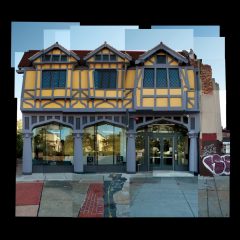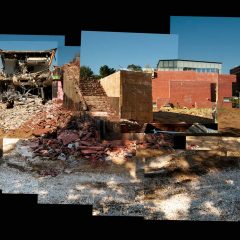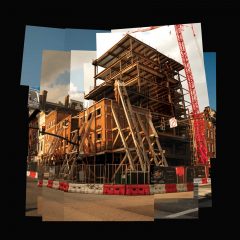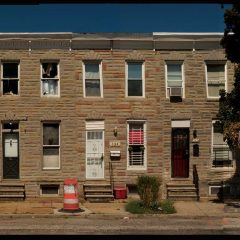Each year, the Philadelphia chapter of the American Institute of Architects (AIA) and the Center for Architecture and Design host one of their most significant events — the Louis I. Kahn Memorial Award + Talk — which honors the contributions of a renowned architect while raising funds to support the next generation of designers at Charter High School for Architecture + Design. The Kahn lecture, named in remembrance of Philadelphia’s legendary architect, Louis Kahn [1901-1974], is now in its 33rd year and has featured international and local “starchitects” including Joseph Esherick (1993), Robert Venturi (1986), and Barnes’ designers Billie Tsien & Tod Williams (2007).
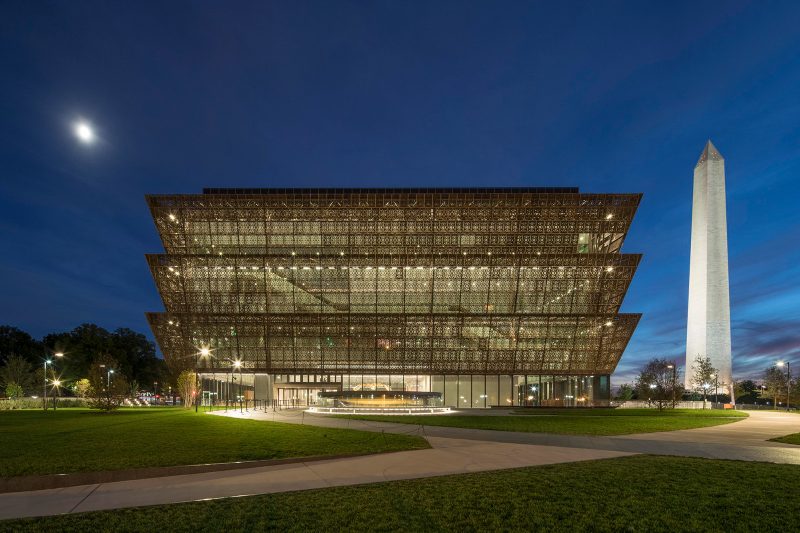
This year’s invited guest was Sir David Adjaye OBE, a Tanzanian-born British architect, educator, and father of two, who is renowned worldwide for provocative work rooted in cultural symbolism. Recently, TIME magazine named Adjaye one of 2017’s “100 Most Influential People.” As his title suggests, he was also knighted (in 2017) by her Majesty Queen Elizabeth II for his outstanding contributions to architecture.
The portfolio of Adjaye’s firm, Adjaye Associates, ranges vastly in typology, scale, and budget, as evidenced by the five curated projects that he presented in his lecture: an open library installation on South Korea’s Gwangju riverfront, a mixed-use affordable housing complex and new art museum in Harlem, a low-budget community library on the outskirts of Washington, D.C., and a museum for African American History and Culture on the National Mall in D.C. The lecture provided insight into Adjaye’s diligent design process, which pays homage to history and craft through meaningful articulation of geometry and materiality. Even on lower-budget projects, he produces compelling designs that convey a narrative through architecture.
A rose in black and Spanish Harlem grows up through concrete
Adjaye jokes that his Sugar Hill project, a 13-story affordable housing, educational, and cultural complex in Upper Harlem is really about his infatuation with Aretha Franklin’s cover of the song, “Spanish Harlem.” Despite the seemingly literal translation from song to concept, I found the evolution of this challenging and relatively low-budget project to be the quintessence of his work. It tells a story about Harlem, a community of rich neoclassical architecture with Sullivan-esque ornamentation, once at the heart of a cultural Renaissance.
At first glance, the Sugar Hill project appears introverted, with a signature dark façade and modest punched windows devouring the entirety of an urban block. The structure’s “stepped sawtooth” geometry reflects the adjacent terraced row-homes, breaking up the building’s massive scale. On closer inspection, however, there is subtle patterning on the building’s skin that gives it a Cheetah-print appearance in New York’s concrete jungle.
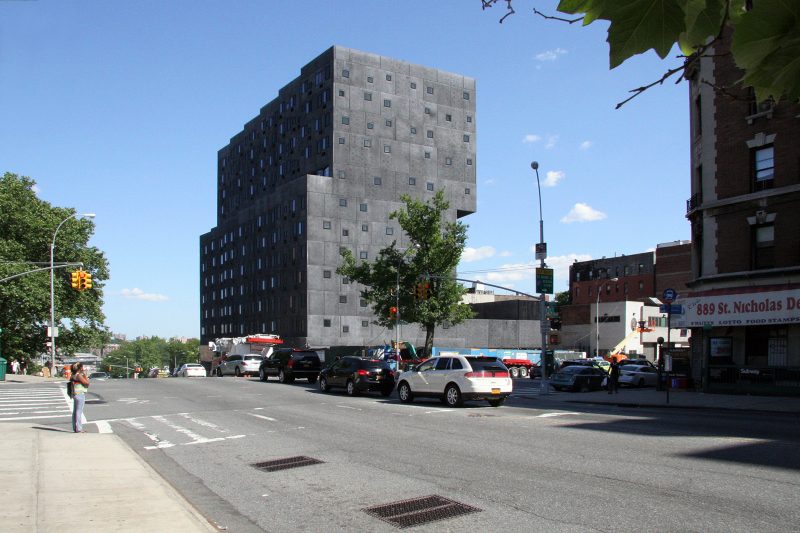
Adjaye shows a photograph of pink roses, taken by his design team in one of Harlem’s omnipresent heritage rose gardens, that served as inspiration for the project. The image was first abstracted to create a figure-ground pattern that was then etched into the concrete panels of the building’s façade. The result is a surface that subtly places the flora and fauna detailing of the surrounding historic architecture into a contemporary dialogue. When the sun shines perpendicular onto the serrated grooves, the imagery disappears, but as the sun moves throughout the day, the shadows cast within the variable trenches create a series of ephemeral patterns.
Sugar Hill tells a story of empowerment that is for the local Harlem community. Providing housing for the homeless, educational and cultural amenities, as well as public space for gatherings, Adjaye sought out a challenging project with a social agenda in order to improve a marginalized community. Though he acknowledges, and at times is apologetic for, the realistic constraints the project faced due to limited resources, he nevertheless persevered by pushing modest design moves that yield a significant impact.
If these walls could talk
Adjaye explains that the ambition of his design for the Smithsonian National Museum of African American History and Culture is to tell a story from the moment you set eyes on the structure — to bring the museum to the exterior:
The thought was to really see if one could make a fiction, and the fiction was what would happen if the 400 year slave trade did not happen. What would happen if architecture just developed from that incredible moment of extraction in Africa, where the arts of that period move from figuration to extraordinary abstraction.
Unless you’re a connoisseur of classical African Art, your Rorschach perception would probably not correlate the museum’s three triangulated tiers to the “corona” (crown) of a Yoruba caryatid. Programmatically, these three layers represent the museum’s evolutionary chapters: ascending from the history of slavery, from migration to freedom, and contemporary culture and community. Metaphorically, they symbolize the extraction and integration of a profound history, where the concepts of “labor and geometry,” derived from slavery and African art, contribute to the building of America. Adjaye compares his elusive use of symbolism to African traditions in which master craftsmen carve allegories into figurative wooden sculptures that are then concealed in holy shrines, never to be seen. Yet their stories prevail.
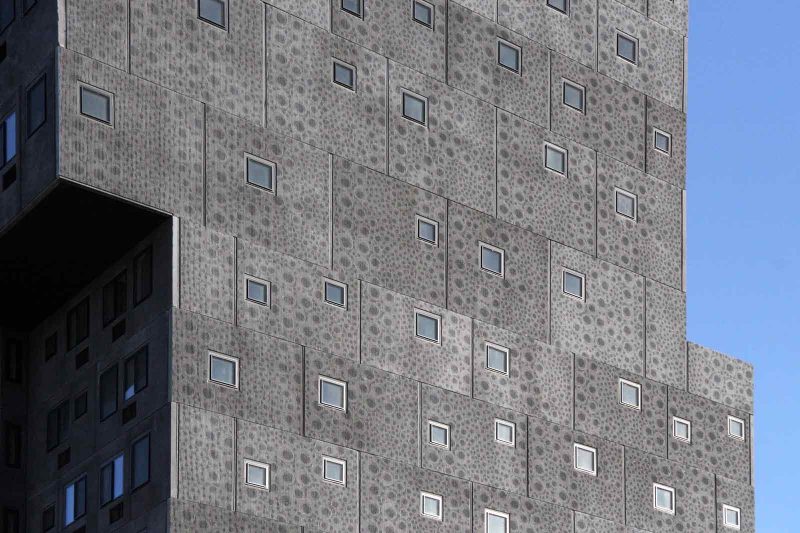
As with the rose-patterned façade of Sugar Hill, here Adjaye adopts the process of abstraction as a method of modernizing, celebrating, and memorializing the subjects of his work. Adjaye applies this concept in the detailing of the luminous bronze screens that form the museum’s corona. He presents a photo of traditional Southern-style housing, the kind you would see in New Orleans, and zooms in on an ornate ironwork panel believed to be the handiwork of a formerly enslaved person whose metalwork was prominent throughout Charleston. For the Smithsonian project, Adjaye’s design team arduously mapped this screen’s French-inspired floral motif onto a grid, transcribing key geometries, then triangulating, tessellating, and mirroring them to create a concept for the museum’s bronze panels.
These panels vary in transparency in order to respond both to the sun and to programmatic elements on the museum’s interior that require more or less visibility. The result is a dynamic facade that changes with time, much like history. An aerial view of the National Mall shows the museum’s contrasting bronze façade against the surrounding marble institutions, which Adjaye jokingly refers to as the “dark fellow in white context.” At night, light filters through the screen, unveiling its delicate ornamentation and shining as a lantern within the memorial landscape.
The lecture concludes in a standing ovation for Sir Adjaye. His inspiring words, spoken in a meditative British accent, are both humble, and thought-provoking. Through his accounts of the $80 million Sugar Hill project and the $540 million National Museum of African American History and Culture, he challenges the notion that affordable structures have to be subpar or any less thoughtfully designed than those with immense budgets. Whether or not you appreciate Adjaye’s unique aesthetic, it is clear that rooted within his architecture are profound stories with ambitious social agendas.
An exhibition of Sir David Adjaye’s select work will be featured at The Center for Architecture + Design` from May 17 through August 16, 2018.


